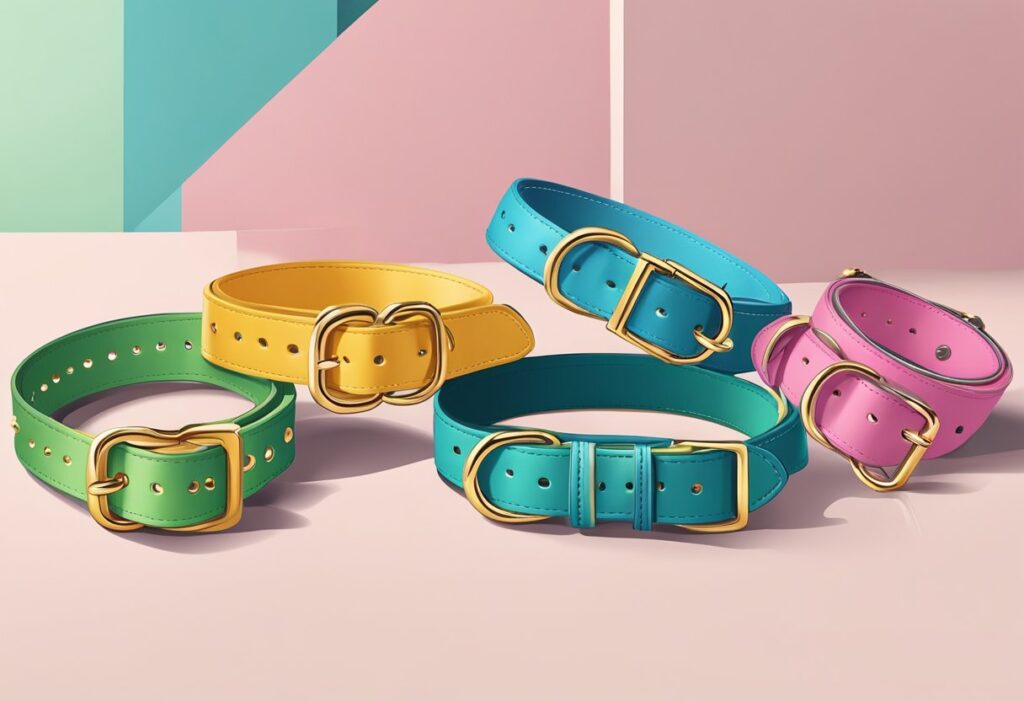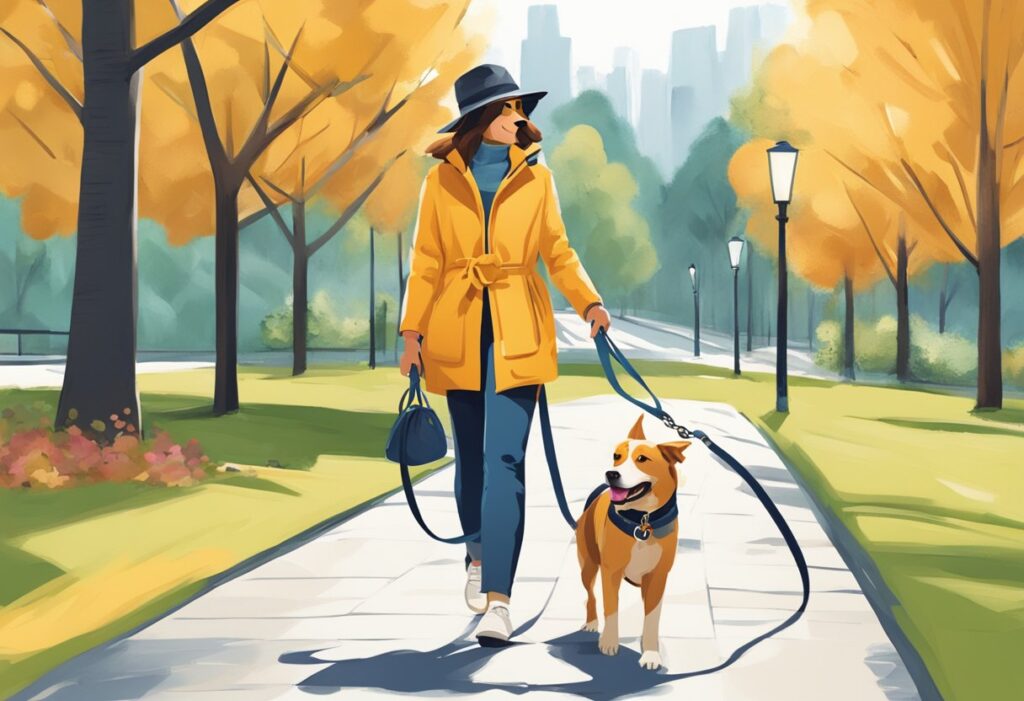Dog collars and leashes are essential tools for every pet owner, combining style with functionality for enjoyable walks. We can choose from a variety of designs that cater to our dog’s needs while reflecting our personal taste. These accessories play a crucial role in ensuring our pets are safe, secure, and comfortable during outdoor adventures.

As we explore different options, it becomes clear that a smart selection of collars and leashes can enhance not only our pet’s comfort but also their training experiences. Modern materials and innovative designs offer features such as durability, ease of use, and added safety measures that can make a difference in our daily routines. By paying attention to both functionality and style, we can find the perfect accessories to suit both our dog’s personality and our lifestyle.
It’s important to remember that the right collar and leash go beyond mere aesthetics; they serve practical purposes that benefit our dogs and our experiences together. Walking our dogs should be a joyful activity that allows us to bond with them and enjoy the outdoors, making the selection of the right gear all the more vital.
Key Takeaways
- Collars and leashes are crucial for safety and style.
- Functional features support comfort and training effectiveness.
- Selecting the right gear enhances the overall walking experience.
Understanding Collars and Leashes
When selecting collars and leashes for our dogs, we need to consider both functionality and style. The right choices can enhance our pet’s comfort and safety, while also reflecting our personal taste.
Types of Dog Collars
There are several types of dog collars to choose from, each serving different purposes. Flat collars are the most common and suitable for everyday use. They come in various materials, including nylon and leather, making them both durable and stylish.
Martingale collars are ideal for dogs that tend to pull. They tighten slightly when needed, preventing escapes while remaining comfortable. For a personal touch, we can opt for a personalized collar, adding our dog’s name and contact information. Each option caters to different needs, so selecting the right one is essential for our dog’s safety and comfort.
Choosing the Right Dog Leash
Selecting a dog leash is just as crucial. Standard dog leashes are typically around six feet long, providing a good balance between freedom and control. For more active or larger dogs, a belt-style leash can offer additional support during walks.
Retractable leashes allow for adjustable length, which can be beneficial in open spaces. However, we must use them cautiously, as they may not provide the same level of control in crowded areas. It’s important to match the leash type to our dog’s behavior and size to ensure a safe and pleasant walking experience.
Functional Features of Canine Accessories

When choosing dog collars and leashes, we need to prioritize functional features that enhance the walking experience. This includes the materials used, safety elements integrated, and the comfort for our pets. Let’s explore these critical aspects.
Materials and Durability
The materials of collars and leashes directly impact their lifespan and usability. Nylon collars are a popular choice due to their lightweight and flexible nature. They are often water-resistant, making them suitable for various weather conditions.
On the other hand, leather collars offer durability and a classic aesthetic. They can withstand strong pulls and general wear while providing a sophisticated look.
We should consider hands-free leashes as well, especially for active owners. These leashes are typically made from durable materials, allowing us to enjoy our walks without constantly holding onto a traditional leash.
Safety Elements
Safety is paramount in our selection process. Collars should have features like breakaway clasps that release if the collar gets caught on something, which prevents injury.
Reflective stitching or materials in collars and leashes enhance visibility during nighttime walks. This extra safety feature can make a significant difference in preventing accidents.
For more secure control, some leashes come with built-in traffic handles. These handles allow us to quickly restrain our dogs in crowded areas, adding an additional layer of safety.
Comfort and Ergonomics
Comfort is essential for our dogs during walks. Collars made from padded materials can help reduce chafing and rubbing on their necks. A well-fitted collar is crucial, ensuring it’s snug but not too tight.
When it comes to leashes, ergonomic grips are key. We should look for leashes with padded handles, which can prevent hand fatigue.
Incorporating features like adjustable lengths can also enhance comfort. With a longer leash, our dogs can explore while still maintaining control, which is beneficial for their enjoyment during walks.
Stylish Considerations for Dog Wearables

When selecting dog collars and leashes, style plays a significant role alongside functionality. We explore how personalization enhances the unique identity of our pets and the balance between fashion and practicality in dog wearables.
Personalization Options
Personalized collars provide an excellent way to express our dog’s unique personality. Options range from custom embroidery to engraved tags, allowing us to showcase their name and our contact information. We can choose from various fabrics, colors, and designs to find the perfect match.
Leather collars are particularly popular for their durability and classic look. We can personalize leather options with unique stitching or embossed designs, creating a sophisticated and functional accessory. This ensures that our dogs not only look stylish but also have a collar that lasts through daily wear and tear.
Fashion versus Function
While style is key, functionality should never be overlooked. We need collars and leashes that withstand our dog’s activity level and lifestyle. Fashionable options such as patterned leashes or embellished collars should still offer comfort and safety during walks.
We should consider materials like sturdy nylon for leashes or soft padded collars that prevent irritation. Balancing these elements ensures we choose designs that are not only visually appealing but also serve practical purposes. By combining aesthetics and utility, we can provide our dogs with attractive wearables that enhance their everyday experiences.
The Role of Collars and Leashes in Training

Collars and leashes play a crucial role in dog training, providing control and communication between us and our dogs. Understanding the right types of collars and leashes can enhance our training effectiveness and create a positive experience for our pets.
Training Collars Explained
Training collars come in various styles, each designed for specific training needs. A popular option is the martingale collar, which tightens slightly when the dog pulls but does not choke. This type provides a gentle yet effective way to discourage unwanted behavior without causing harm.
We should also consider flat collars, which are suitable for everyday use and can hold ID tags. While not specifically for training, they offer a foundation for leash control without being overly restrictive. Choosing the right collar involves factoring in the dog’s size, breed, and individual behavior.
Leashes for Training Scenarios
The type of leash we choose significantly impacts our training sessions. For basic training, a standard 6-foot leash allows control while giving our dog enough freedom to explore. This length is ideal for practicing commands in open spaces.
For more advanced training, a training leash with a traffic handle can be valuable. This gives us immediate control close to our dog, especially in busy areas. Additionally, long lines can be useful for recall training, providing distance while maintaining a connection.
In each scenario, we should keep the leash relaxed to encourage a calm learning environment and promote better focus during training.
Check out the Dog Training 101.
Accessorizing for Different Environments

When choosing dog collars and leashes, we must consider how different environments impact our needs. Urban and rural settings, as well as indoor and outdoor scenarios, dictate specific choices that enhance functionality while ensuring our dog’s comfort and safety.
Urban Versus Rural Settings
In urban environments, we often encounter various stimuli—traffic, crowds, and noise. A sturdy collar and leash are essential for control. A dog harness can provide extra security, especially for strong pullers. Reflective materials on leashes increase visibility during evening walks, ensuring safety.
In contrast, rural settings may offer more space for our dogs to roam. A lightweight collar might suffice in open areas. However, we should still consider durable options for off-leash adventures, as well as leashes that can easily clip onto a dog park post or harness. The right gear allows us to enjoy the open spaces while ensuring our dogs are secure and identifiable.
Indoor Versus Outdoor Gear
Indoor settings typically require less robust gear. A soft, adjustable collar may be enough for home use. For playdates or visits from pet friends, consider lightweight, colorful collars that reflect our pets’ personalities.
For outdoor activities, our gear needs to be more durable. Heavy-duty leashes are ideal for hiking or long walks. If our dog is prone to escaping, a hiking harness provides more security and comfort during active outings. We must also think about the weather, ensuring waterproof materials when needed. This helps keep our pets dry while allowing us to enjoy our time outdoors.





